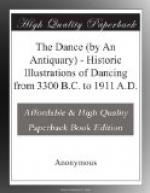[Illustration: Fig. 27—Bacchante. From a fresco, Pompeii, 1st century B.C.]
[Illustration: Fig. 28.—Dancer. From a fresco in the Baths of Constantine, 4th century A.D.]
Perhaps the encouragement of the more brutal combats of the Coliseum did something to suppress the more delicate arts, but historians have told us, and it is common knowledge, what became of the great Empire, and the lyric with other arts were destroyed by licentious preferences.
CHAPTER IV.
THE “EARLY ENGLISH” AND “MEDIAEVAL” DANCE TO THE FOURTEENTH CENTURY.
The last illustration from the Baths of Constantine brought us into the Christian era, although that example was not of Christian sentiment or art. It is possible that the dance of Salome with its diabolical reward may have prejudiced the Apostolic era, for we find no example of dancing, as exhibiting joy, in Christian Art of that period. The dance before Herod is historical proof that the higher classes of Hebrews danced for amusement.
As soon, however, as Christianity became enthroned, and a settled society, we read of religious dances as exhibiting joy, even in the churches. Tertullian tells us that they danced to the singing of hymns and canticles. These dances were solemn and graceful to the old tones; and continued, notwithstanding many prohibitions such as those of Pope Zacharias (a Syrian) in A.D. 744. The dancing at Easter in the Cathedral at Paris was prohibited by Archbishop Odo in the 12th century, but notwithstanding the antagonism of the Fathers, the dances were only partially suppressed.
They were common on religious festivals in Spain and Portugal up to the seventeenth century and in some localities continue even to our own time. When S. Charles Borromeo was canonized in 1610, the Portuguese, who had him as patron, made a procession of four chariots of dancers; one to Renown, another to the City of Milan, one to represent Portugal and a fourth to represent the Church. In Seville at certain periods, and in the Balearic Isles, they still dance in religious ceremonies.
We know that religious dancing has continually been performed as an accessory to prayer, and is still so used by the Mahommedans, the American Indians and the Bedos of India, who dance into an ecstasy.
[Illustration: Fig. 29.—Gleemen’s dance, 9th century. From Cleopatra, Cotton MS. C. viii., British Museum.]
It is probable that this sort of mania marked the dancing in Europe which was suppressed by Pope and Bishop. This choreomania marked a Flemish sect in 1374 who danced in honour of St. John, and it was so furious that the disease called St. Vitus’ dance takes its name from this performance.
Christmas carols were originally choric. The performers danced and sang in a circle.




